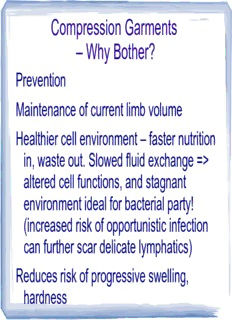
Carol Armstrong, RMT PDF
Preview Carol Armstrong, RMT
Compression Garments – Why Bother? Prevention Maintenance of current limb volume Healthier cell environment – faster nutrition in, waste out. Slowed fluid exchange => altered cell functions, and stagnant environment ideal for bacterial party! (increased risk of opportunistic infection can further scar delicate lymphatics) Reduces risk of progressive swelling, hardness Why Bother? Provides measure of skin protection against various trauma Minimizes future complications when combined with other risk reduction practices Initial diligence and ongoing persistence => payoff of “garment free pass” for “special occasions” Gives YOU control over your LE NIH & NNMC STUDY 2001-2006 Followed n=196 newly dx BCRA pts Prior to surgery, then 3 mth intervals following surgery up to one year. Ave onset 6.9mths after surgery. Perometry identified sub-clinical LE in 43 pts (83ml or 3% volume change) Treated with ready made sleeve and gauntlet. Results within 4.4 wks, volume reduced ave of 48ml, ie ~50%. (almost to size of unaffected arm). Results maintained at 4.8mth follow-up Early intervention at this stage when LE is reversible, (lymph stasis is more fluid like rather than more viscous, no dermal chang es) Stout et al 2011 (Am Jnl Phy Med Rehab) LE likely starts in subfascial layers, and by time lymphatic reflux affects skin lymphatics (in superficial fascia), LE well on way to Stage II, a less reversible stage which does not respond as quickly to simple sleeve compression Also noted - One of highest risk factors for developing LE is obesity. This may prevent some patients from using ready made garments because it is imperative that the sleeve fits the limb appropriately. Effective Compression should... Reduce the ultrafiltration rate – limit excessive arteriole outflow into the tissue spaces, which means less fluid for lymphatics to remove. Prevents re- accumulation of evacuated fluid by preventing re-expansion of tissues. Enhance efficiency of muscle/joint pump – provide a resistance barrier against muscle contraction, forcing more fluid into venous and lymphatic systems. Wear garment during resistive exercise (increase fluid removal) and after exercise (maintain reduction) Effective Compression should... Help restore valvular function in deeper lymphatics and venous vessels (by bringing flaps into closer proximity and thereby reducing backflow) Maintain/restore glide in superficial fascia => important in slowing and reversing the proliferation of skin and connective tissue changes (fibrosis, sclerosis, hypertrophic scars) Effective Lymphedema Garments (Great, Chocolate Fudge For Dinner!) • GRADUATED – designed to apply greatest pressure distally eg foot, decreasing proximally eg thigh • Appropriate Compression CLASS – Too low will not prevent the limb from re-filling Too high will constrict blood and nerve supply, causing discomfort • Appropriate FABRIC Construction for STAGE of LE (Round vs Flat knit) • FIT WELL • WORN DAILY Compression Classes (mmHg) Measured in millimetres of mercury (mmHg) Refers to amount of pressure exerted by the garment at its most distal end, eg ankle or wrist with decreasing pressure proximally eg top of leg or arm No international standardisation of classes. Varies within and between manufacturers Varies between upper and lower limb North American European Class I 20-30 mmHg Class I 18-21mmHg Class II 30-40 mmHg Class II 21-32mmHg Class III 40-50 mmHg Class III 34-46mmHg Class IV 50-60 mmHg Class IV 49-70mmHg Choice of Class for LE Dependent on: Stage of LE; sub-clinical, mild, moderate, severe Patient age, lifestyle, limb volume, tissue hardness, muscle tone, co-morbidities (eg COPD, diabetes), mobility, assistance at home to don/doff garment if needed. General rule of thumb: Class I and II for upper extremity Classes I-V for lower extremity. Lower extremity ABPI important especially if wound present
Description: